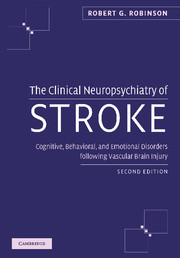 The Clinical Neuropsychiatry of Stroke
The Clinical Neuropsychiatry of Stroke Book contents
- Frontmatter
- Contents
- Preface
- Part I Introduction
- Part II Poststroke depression
- Part III Poststroke mania
- 24 Prevalence and clinical symptoms
- 25 Clinical and lesion correlates of poststroke mania
- 26 Bipolar disorder following stroke
- 27 Mechanism of mania following stroke
- 28 Treatment of mania following stroke
- Part IV Poststroke anxiety disorders
- Part V Other poststroke disorders
- Index
24 - Prevalence and clinical symptoms
from Part III - Poststroke mania
Published online by Cambridge University Press: 01 October 2009
- Frontmatter
- Contents
- Preface
- Part I Introduction
- Part II Poststroke depression
- Part III Poststroke mania
- 24 Prevalence and clinical symptoms
- 25 Clinical and lesion correlates of poststroke mania
- 26 Bipolar disorder following stroke
- 27 Mechanism of mania following stroke
- 28 Treatment of mania following stroke
- Part IV Poststroke anxiety disorders
- Part V Other poststroke disorders
- Index
Summary
Since the first edition of this text in 1998, the literature on mania following stroke continues to be dominated by anecdotal reports and small series of cases examining risk factors for secondary mania. Secondary mania is generally defined as mania following a precipitating causative event such as head injury, stroke, or drug exposure (Rosenbaum and Barry 1975; Krauthammer and Klerman 1978; Forrest 1982). Cohen and Niska (1980) first reported on lesion location associated with secondary mania and suggested an association with right hemisphere injury. Two cases of poststroke mania were reported by Jampala and Abrams (1983) in which one patient with a left and one with right hemisphere cortical infarction developed mania. Cummings and Mendez (1984) also reported two cases of mania occurring within a few days following right hemispheric thalamic infarctions. Both patients were in their 60s with no previous history of psychiatric disorder and no family history of mood disorder. After a review of the literatre, Cummings and Mendez suggested that right hemisphere lesions appear to be frequently associated with the onset of secondary mania. In addition, case reports have suggested that patients with “secondary” mania are older than those with “primary” (i.e., no associated organic precipitant) mania and have a lower frequency of positive family history of psychiatric disorder (Krauthammer and Klerman 1978; Starkstein et al. 1987).
- Type
- Chapter
- Information
- The Clinical Neuropsychiatry of StrokeCognitive, Behavioral and Emotional Disorders following Vascular Brain Injury, pp. 283 - 287Publisher: Cambridge University PressPrint publication year: 2006


